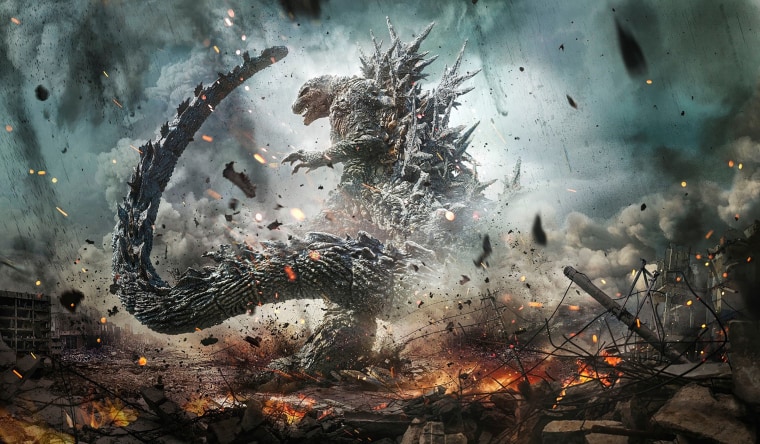begin quote from:
https://www.nbcnews.com/pop-culture/godzilla-minus-one-box-office-movie-success-hollywood-rcna128389
Rave reviews and box office records: How 'Godzilla Minus One' took the U.S. by storm

Godzilla has burst into the box office this December, a twist Hollywood didn’t see coming.
“Godzilla Minus One,” the 33rd installment in the Japanese-language movie franchise, has broken multiple domestic box-office records and drawn critical acclaim since its release on Dec. 1, doing so on a budget that would make most movie producers balk.
As of Thursday, the movie has brought in more than $15.7 million in U.S. ticket sales, according to Comscore. That’s more than its reported $15 million budget.
Its commercial success may yet be dwarfed by the critical response. As of Thursday, “Godzilla Minus One” had received a 97% score on Rotten Tomatoes from 96 reviews, with a 98% audience approval score.
The unanticipated hype comes as many moviegoers find themselves exhausted by what they see as a decline in the quality of some of their favorite franchises, particularly superhero films.

Last month, Disney’s “The Marvels” — part of the vast Marvel Cinematic Universe — opened with an estimated $47 million domestically over its debut weekend, the lowest in the history of the 30-plus-film franchise. Like many Marvel movies, it came with a hefty price tag. Other highly anticipated action films, like “The Flash” and “Indiana Jones and the Dial of Destiny” (the fifth movie in the franchise), also underperformed.
Paul Dergarabedian, the senior media analyst for Comscore, said the new Godzilla added to a recent spate of surprise successes, including “Barbie,” “Oppenheimer” and even “Sound of Freedom.”
“Lately, it hasn’t been the tried and true,” he said. “It’s been the outside-of-the-box thinking or movies that have a unique point of view, or not trying to just replicate what was successful before.”
“Minus One” has also reminded fans that action movies can still be good — even when they’re based on recycled characters.
The film is set in Japan just after World War II and follows civilians who are just starting to recover when they face another mortal threat: Godzilla. It marked a return to the franchise for Toho Studios, which hadn’t made a movie with the monster since 2016. In the years following, countless other variations and sequels have been made — some to box office acclaim and others to lukewarm reaction.
Since its release, a handful of discussions on the community-focused website Reddit have been buzzing with one question in particular: How is the film so good? On X, others have also had similar reactions. Some lamented that bigger-budget action films have paled in comparison.
Takashi Yamazaki, the film’s director, writer and VFX supervisor, told The Verge he wanted to “bring some of that original intention behind Godzilla back.”
“Out of all the Godzillas there have been throughout the years — scary Godzilla, cute Godzilla, the more heroic Godzilla, etc. — my favorite is still the original from the very first movie,” he said.
He also “wanted to look at how the war affected people at that time” and tell a more human story, through the lens of the film’s lead character, former kamikaze pilot Kōichi Shikishima (Ryunosuke Kamiki).
“Everyone’s already living with post-traumatic stress disorder and not knowing how to carry on,” he said. “But then Godzilla shows up, and while the situation becomes even more dire, the threat he poses is also what gives people like [Kōichi] Shikishima a reason to step up to the occasion.”
U.S. audiences will be getting more Godzilla next year. The first trailer for “Godzilla x Kong: The New Empire” debuted this week, though it was already drawing some scrutiny for a clip of the Japanese lizard running (Godzilla tends to be relatively slow and plodding in most movies).
Dergarabedian noted that quality and creativity trump concerns about whether audiences might be burnt out on particular characters.
Audiences don’t have “Godzilla fatigue,” he said. “It’s not even action movie fatigue. It’s bad movie fatigue. Or movies that just don’t push the envelope enough for audiences to get on board.”
When moviegoers get what they feel are “fresh” offerings, buzz often generates organically, he added.
Both “Oppenheimer” and “Barbie” — two very different films that upon their simultaneous release became known as the cultural phenomenon “Barbenheimer” — were released by big Hollywood studios (Universal Pictures and Warner Bros., respectively). But like “Godzilla Minus One,” they also offered a “non-cookie cutter experience” to viewers. (NBC News and Universal Pictures are both units of NBCUniversal.)
“Trying to get a handle on what audiences want is very tough,” Dergarabedian said. “I think there’s a huge underestimation of what audiences want. Using the conventional wisdom that makes for some very watered-down content is getting boring to audiences. They want to be pushed.”


No comments:
Post a Comment